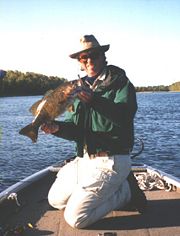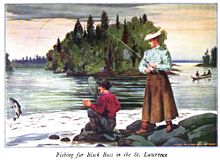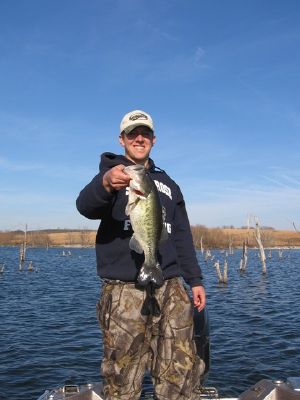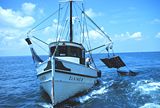Difference between revisions of "Bass fishing" - New World Encyclopedia
Keisuke Noda (talk | contribs) |
Keisuke Noda (talk | contribs) |
||
| Line 26: | Line 26: | ||
==Rise of Modern Bass Fishing== | ==Rise of Modern Bass Fishing== | ||
[[Image:Largemothbassbaby.JPG|right|thumb|''Example of a very young specimen of M. salmoides (Largemouth Bass) caught by an angler in [[Minnesota]].'']] | [[Image:Largemothbassbaby.JPG|right|thumb|''Example of a very young specimen of M. salmoides (Largemouth Bass) caught by an angler in [[Minnesota]].'']] | ||
| − | By the early 1900s, bass fishing had been well established as a sport with its own following. Though the use of artificial lures for bass had begun with the [[Artificial fly|artificial fly]] and [[fly fishing]] tackle, the bait casting rod and reel soon came to dominate the sport. Although fixed-spool reels were introduced in use in the United States as early as the 1870s, [[fishing reel|spinning]] reels and [[fishing rod|rods]] did not gain wide acceptance as an angling tool until the 1950s.<ref> | + | By the early 1900s, bass fishing had been well established as a sport with its own following. Though the use of artificial lures for bass had begun with the [[Artificial fly|artificial fly]] and [[fly fishing]] tackle, the bait casting rod and reel soon came to dominate the sport. Although fixed-spool reels were introduced in use in the United States as early as the 1870s, [[fishing reel|spinning]] reels and [[fishing rod|rods]] did not gain wide acceptance as an angling tool until the 1950s.<ref>[http://www.orcaonline.org/reel_history.htm Reel History], O.R.C.A. Online. Retrieved July 30, 2008.</ref> Since that time, most bass anglers have used bait casting or spinning tackle, using either artificial lures or live bait (See Fishing rod, Fishing reel). |
During the 1950s and 1960s, the development of specific angling tools for bass significantly increased angler success and helped stimulate the development of the sport. Some of these innovations include the invention of monofilament nylon fishing lines, the [[fiberglass]] (later [[graphite]] composite) fishing rod, the electric trolling motor, the fish finder/depth locator, and new artificial lures and baits made of various plastics. Recently, advanced electronics that mimic the sounds of schooling bait fish have been introduced, and a controversy has arisen over the proper use of these devices in bass tournament fishing. | During the 1950s and 1960s, the development of specific angling tools for bass significantly increased angler success and helped stimulate the development of the sport. Some of these innovations include the invention of monofilament nylon fishing lines, the [[fiberglass]] (later [[graphite]] composite) fishing rod, the electric trolling motor, the fish finder/depth locator, and new artificial lures and baits made of various plastics. Recently, advanced electronics that mimic the sounds of schooling bait fish have been introduced, and a controversy has arisen over the proper use of these devices in bass tournament fishing. | ||
Revision as of 19:43, 30 July 2008
| fishing |
|---|
| game fishing |
| big game |
| swordfish |
| marlin |
| bass |
| sharks |
| salmon run |
| sport fish |
| fly fish |
| IGFA |
|
|
| angling |
| recreational |
|
|
| I N D E X |
Bass fishing is the sport of angling for the North American gamefish known colloquially as the black bass. There are numerous black bass species considered as gamefish in North America, including largemouth bass (Micropterus salmoides), smallmouth bass (Micropterus dolomieui), spotted bass or Kentucky bass (Micropterus punctatus), Guadalupe bass (Micropterus treculii), and many other species and subspecies of the genus Micropterus. Though referred to as bass, all are actually members of the sunfish family (Centrarchidae: order Perciformes).
Modern bass fishing has evolved into a multi-billion dollar industry[1] The sport has changed drastically since its beginnings in the late 1800s. From humble beginnings, the black bass has become the second most specifically sought-after game fish in the United States. The sport has driven the development of all manner of fishing gear, including rods, reels, lines, lures, electronic depth and fish-finding instruments, drift boats, float tubes, and specialized bass boats.
The Sport
All black bass are well-known as strong fighters, and are fished recreationally. Depending upon species and various other factors such as water quality and availability of food, black bass may be found in lakes, reservoirs, ponds, rivers, streams, creeks, even roadside ditches. Largemouth are known for their overall size and resistance when hooked, favoring short, powerful runs and escape to cover such as submerged logs or weedbeds.[2] Smallmouth bass tend to jump more and fight aggressively on the surface when hooked, in order to throw the hook. Bass are usually fileted when taken for the table, and the flesh is white and firm, with a delicate taste when cooked.[3] However, more bass anglers are adopting "catch and release" angling where the bass are returned to the water after being hooked and retrieved.
Background
Bass fishing in the United States largely evolved on its own, and was not influenced by angling developments in Europe or other parts of the world. Indeed modern British sea bass fisherman look to the United States freshwater bass techniques for inspiration for lure fishing and to the USA, Japan and China for tackle. During the early to mid-1800s, wealthy sport anglers in the United States (mostly located in the northeastern portion of the country) largely confined themselves to trout and salmon fishing using fly rods. While smallmouth bass were sought by some fly fishermen[4], most bass fishing was done by sustenance anglers using poles and live bait. The working-class heritage of bass fishing strongly influenced the sport and is manifested even today in its terminology, hobbyist literature, and media coverage.[5]
Sometime during the mid-1800s, the first artificial lure used for bass was developed in the form of an artificial fly. At first, these artificial fly patterns were largely derivations of existing trout and salmon flies. As time went on, new fly patterns were specifically developed to fish for bass, as well as heavier spinner/fly lures that could be cast by the baitcasting and fixed-spool casting reels and rods available at the time.[6][7] Floating wooden lures (plugs) or poppers of lightweight cork or balsa were introduced around 1900, sometimes combined with hooks dressed with artificial fur or feathers.[8]
In the United States, the sport of bass fishing was greatly advanced by the stocking of largemouth and smallmouth bass outside their native ranges in the latter portion of the 19th century. As the nation's railroad system expanded, large numbers of 'tank' ponds were built by damming various small creeks that intersected the tracks in order to provide water for steam engines; later, new towns often sprang up alongside these water stops. Shippers found that black bass were a hardy species that could be transported in buckets or barrels via the railroad, sometimes using the spigot from the railroad water tank to aerate the fingerlings.[9]
Largemouth bass were often stocked in tank ponds and warmer lakes, while smallmouth bass were distributed to lakes and rivers throughout the northern and western United States, as far west as California. Smallmouth were transplanted east of the Appalachians just before the Civil War, and afterwards introduced into New England.[10][11]
Largemouth bass populations boomed after the U.S. Department of Agriculture began to advise and assist farmers in constructing and stocking farm ponds with largemouth bass, even offering advice on managing various fish species. Soon, those who had stocked largemouth bass on their farm ponds began to pursue them on a burgeoning number of new reservoirs and impoundments built in the United States during the 1940s and 1950s. These impoundments coincided with a postwar fishing boom, supplying additional funds from sales of fishing licenses for the first large-scale attempts at bass fisheries management. This was especially true in the southern United States, where the largemouth bass thrived in waters too warm or turbid for other types of gamefish.[12][13]
With increased industrialization and development, many of the nation's eastern trout rivers were dammed, polluted, or allowed to silt up, raising water temperatures and killing off the native brook trout. Smallmouth bass were often introduced to northern rivers now too warm for native trout, and slowly became a popular gamefish with many anglers.[14] Equally adaptable to large, cool-water impoundments and reservoirs, the smallmouth also spread far beyond its original native range. Later, smallmouth populations also began to decline after years of damage caused by overdevelopment and industrial and agricultural pollution, as well as a loss of river habitat caused by damming many formerly wild rivers in order to form lakes or reservoirs. In recent years, a renewed emphasis on preserving water quality and riparian habitat in the nation's rivers and lakes, together with stricter management practices, eventually benefited smallmouth populations and has caused a resurgence in their popularity with anglers.[15][16]
Rise of Modern Bass Fishing
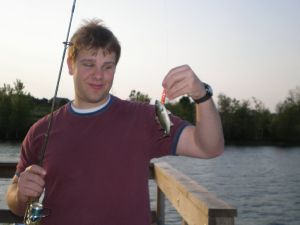
By the early 1900s, bass fishing had been well established as a sport with its own following. Though the use of artificial lures for bass had begun with the artificial fly and fly fishing tackle, the bait casting rod and reel soon came to dominate the sport. Although fixed-spool reels were introduced in use in the United States as early as the 1870s, spinning reels and rods did not gain wide acceptance as an angling tool until the 1950s.[17] Since that time, most bass anglers have used bait casting or spinning tackle, using either artificial lures or live bait (See Fishing rod, Fishing reel).
During the 1950s and 1960s, the development of specific angling tools for bass significantly increased angler success and helped stimulate the development of the sport. Some of these innovations include the invention of monofilament nylon fishing lines, the fiberglass (later graphite composite) fishing rod, the electric trolling motor, the fish finder/depth locator, and new artificial lures and baits made of various plastics. Recently, advanced electronics that mimic the sounds of schooling bait fish have been introduced, and a controversy has arisen over the proper use of these devices in bass tournament fishing.
Since the early 1990s, fly fishing for bass, particularly smallmouth bass, has again become popular, using fly patterns, rods, and fly lines suited for bass.[18][19]
Fishermen, conservation groups, and governmental wildlife departments have introduced black bass of various species across the world for the sport of fishing. Outside North America, Japan and South Africa have active programs.
Bass fishing as a sport was helped along by the chase for the standing world record which has held for over 75 years. Though surrounded by controversy it is widely accepted that in 1932 a 22 pound 4 ounce bass was caught by George Perry in Montgomery Lake, Georgia. It is one of the longest standing records in the sport of fishing.
Population Management
The increasingly popularity of the sport combined with "catch and release" practices have in some cases led to an overpopulation of bass.
An overpopulated, stunted bass population can best be detected in the spring when all the bass are at least one year old. If virtually all the bass are 4 inches long or smaller, the population is probably stunted. Some indicators that a bass population is overpopulated:
(a) The largemouth bass caught are all less than 1 pound and are "skinny." (b) The bluegills are 1/2 pound and larger (too large for the bass to eat). An overpopulation an/or stunting of bass may be caused by several factors including: (a) Not enough bass being harvested. (b) Too few bluegill or redear sunfish were stocked initially or they are failing to reproduce and the bass population does not have an adequate food supply.
Against letting nature sort it out (which it will) it is posited that the easiest way to control an overpopulation of largemouth bass is by increasing the take of bass. This is clearly an effective method of thinning the bass population providing recreation at the same time - which is more important to American Bass anglers. It may take two to three years to bring the population back into balance. If forage fish are scarce, stock adult bluegill or redear sunfish (7 to 8 inches long). These fish will be too large to be eaten by the bass. The large panfish will spawn in the spring and produce a supply of forage. [1]
Other Species
Black bass should not be confused with a multitude of unrelated fish species found around the world and called "bass," such as the butterfly Peacock Bass (Cichla ocellaris), speckled Peacock bass (Cichla temensis), Papuan Black Bass (Lutjanus goldiei) (also called Niugini bass), Australian bass, Rock bass (Ambloplites rupestris), American Striped Bass, and British sea bass (Dicentrarchus labrax).
Competition
There are two major bass fishing competitions in the United States.
One is the Bassmaster Tournament Trail, organized by the Bass Anglers Sportsmen Society (B.A.S.S.). It was started by Ray Scott, the "father" of competitive bass fishing. First held in 1969, today, professionals like Michael Iaconelli, Kevin VanDam, Robert Baney, Edward Paffendorf IV, Aaron Martens, Rick Clunn, and Luke Clausen are household names to many American sports fans. There are 12 events in which the top 50 anglers compete. The top prize in the Bassmasters Classic is $500,000.
The other is the Wal-Mart FLW Tour. The top prize of the Forrest Wood Cup is $1 Million. Both tours are nationally televised on networks like ESPN and Fox Sports Net (ESPN actually owns and operates B.A.S.S.), and covered extensively by news media.
In modern bass fishing competitions, caught bass are placed in a live well, and released as soon as caught and weighed by officials. Competitors are penalized heavily for dead fish and in some cases dead fish are not weighed. Fish turned in for weighing are immediately released or placed in tanks and treated for stress and glyco-protein (slime coat) injury, then released back into the water.
Competitive bass fishing has also spread to anglers in other countries such as Japan, Australia and South Africa.
Notable bass fishermen
- Michael Iaconelli
See also
- Fishing
- Fishing boat
- Fishing rod
- Fishing line
- Fishing reel
- Fly fishing
ReferencesISBN links support NWE through referral fees
- ↑ Williamson, Mary Jane. Angling Retains its Mainstream Appeal and Broad Economic Impact-American Sportfishing Association. Retrieved July 30, 2008.
- ↑ Waterman, Charles F., Black Bass & the Fly Rod, Stackpole Books (1993)
- ↑ Largemouth Bass, Arizona Game & Fish Department, Bass Fishing in Arizona Retrieved July 30, 2008.
- ↑ Henshall, James (Dr.), Book of the Black Bass (1881)
- ↑ Waterman, Charles F., Black Bass & the Fly Rod, Stackpole Books (1993)
- ↑ Waterman, Charles F., Black Bass & the Fly Rod, Stackpole Books (1993)
- ↑ Ryan, Will, Smallmouth Strategies for the Fly Rod, Lyons & Burford Publishers (1996)
- ↑ Waterman, Charles F., Black Bass & the Fly Rod, Stackpole Books (1993)
- ↑ Ryan, Will, Smallmouth Strategies for the Fly Rod, Lyons & Burford Publishers (1996)
- ↑ Waterman, Charles F., Black Bass & the Fly Rod, Stackpole Books (1993)
- ↑ Ryan, Will, Smallmouth Strategies for the Fly Rod, Lyons & Burford Publishers (1996)
- ↑ Waterman, Charles F., Black Bass & the Fly Rod, Stackpole Books (1993)
- ↑ Ryan, Will, Smallmouth Strategies for the Fly Rod, Lyons & Burford Publishers (1996)
- ↑ Waterman, Charles F., Black Bass & the Fly Rod, Stackpole Books (1993)
- ↑ Waterman, Charles F., Black Bass & the Fly Rod, Stackpole Books (1993)
- ↑ Ryan, Will, Smallmouth Strategies for the Fly Rod, Lyons & Burford Publishers (1996)
- ↑ Reel History, O.R.C.A. Online. Retrieved July 30, 2008.
- ↑ Murray, Harry, Fishing for Smallmouth Bass, Lyons Press, 1989
- ↑ Kreh, Lefty, Fishing for Bass, Lyons Press, 2004
Books and Secondary References
- Bauer, Edwin A. (1955). Bass In America-The Haunts, habits and other secrets of one of the worlds' finest freshwater game fish. New York: Simon and Schuster.
- Bergman, Ray (1942). Fresh-water Bass. New York: Willam Penn Publishing Co..
- Brooks, Joe (1947). Bass Bug Fishing. South Brunswick, NJ: A. S. Barnes.
- Clouser, Bob (2007). Fly-Fishing For Smallmouth in Rivers and Streams. Mechanicsburg, PA: Stackpole Books. ISBN 0811701735.
- Dalrymple, Byron (1972). Modern Book of the Black Bass. New York: Winchester Press. ISBN 0876910665.
- Gasque, Jim (1945). Bass Fishing-Technique, Tackle and Tails. New York: Alfred A. Knopf.
- Harris, William C. and Rhead, Louis (ed) (1905). The Basses Fresh-Water and Marine. New York: Frederick A. Stokes and Company.
- Hawes, Harry B. (1930). My Friend The Black Bass. New York: Frederick A. Stokes and Company.
- Henshall, James A. MD (1881). Book of the Black Bass-Angling and Fly Fishing. Cincinnati: Robert Clark & Co..
- Hollis, Harold C. (1945). Bass Tackle and Tactics—Better Sport Through The Use of Lighter Tackle. New York: A. S. Barnes and Company Inc..
- Jones, Sheridan R. (1927). Black Bass & Bass Craft—The life habits of the two bass and successful angling strategy. New York: The MacMillian Company.
- Kesting, Ted (1962). Bass Fishing - Sports Afield Library. New York: Thomas Nelson & Sons.
- Knight, John Alden (1949). Black Bass. New York: G. P. Putnam and Sons.
- Kreh, Lefty (2004). Fly Fishing For Bass. Lyons Press. ISBN 9781592283101.
- Lincoln, Robert Page (1952). Black Bass Fishing-Theory and Practice. Harrisburg, PA: The Stackpole Company.
- Livingston, A.D. (1974). Fishing for Bass—Modern Tactics and Tackle. Philadelphia: J. B. Lippincott Company. ISBN 0397010176.
- Livingston, A.D. (1976). Fly-rodding for Bass. Philadelphia: J. B. Lippincott Company. ISBN 0397011121.
- Livingston, A.D. (1977). Tying Bugs and Flies for Bass. Philadelphia: J. B. Lippincott Company. ISBN 0397011873.
- Murray, Harry (1989). Fly Fishing For Smallmouth Bass. New York: Lyons and Burford Publishers. ISBN 0941130851.
- Ovington, Ray (1983). Tactics on Bass—How to Wade, Cast, and Fish Out Each of 23 Different Kinds of Bass Areas. New York: Charles Scribner's & Sons. ISBN 0684178605.
- Ripley, Ozark (1924). Bass and Bass Fishing. Cincinnati: Sportsman Digest Publishing Co..
- Ryan, Will (1996). Smallmouth Strategies for the Fly Rod. New York: Lyons & Burford Publishers.
- Waterman, Charles F. (1993). Black Bass and the Fly Rod. Mechanicsburg, PA: Stackpole Books. ISBN 0811716309.
- Westmorland, Billy (1976). Them Ol' Brown Fish—Bill Westmoreland on Smallmouths. Nashville, TN: The Parthenon Press.
External links
All links retrieved July 30, 2008.
- Bass fishing, Open Directory Project.
| |||||||||||||||||||||||||||||
Credits
New World Encyclopedia writers and editors rewrote and completed the Wikipedia article in accordance with New World Encyclopedia standards. This article abides by terms of the Creative Commons CC-by-sa 3.0 License (CC-by-sa), which may be used and disseminated with proper attribution. Credit is due under the terms of this license that can reference both the New World Encyclopedia contributors and the selfless volunteer contributors of the Wikimedia Foundation. To cite this article click here for a list of acceptable citing formats.The history of earlier contributions by wikipedians is accessible to researchers here:
The history of this article since it was imported to New World Encyclopedia:
Note: Some restrictions may apply to use of individual images which are separately licensed.
